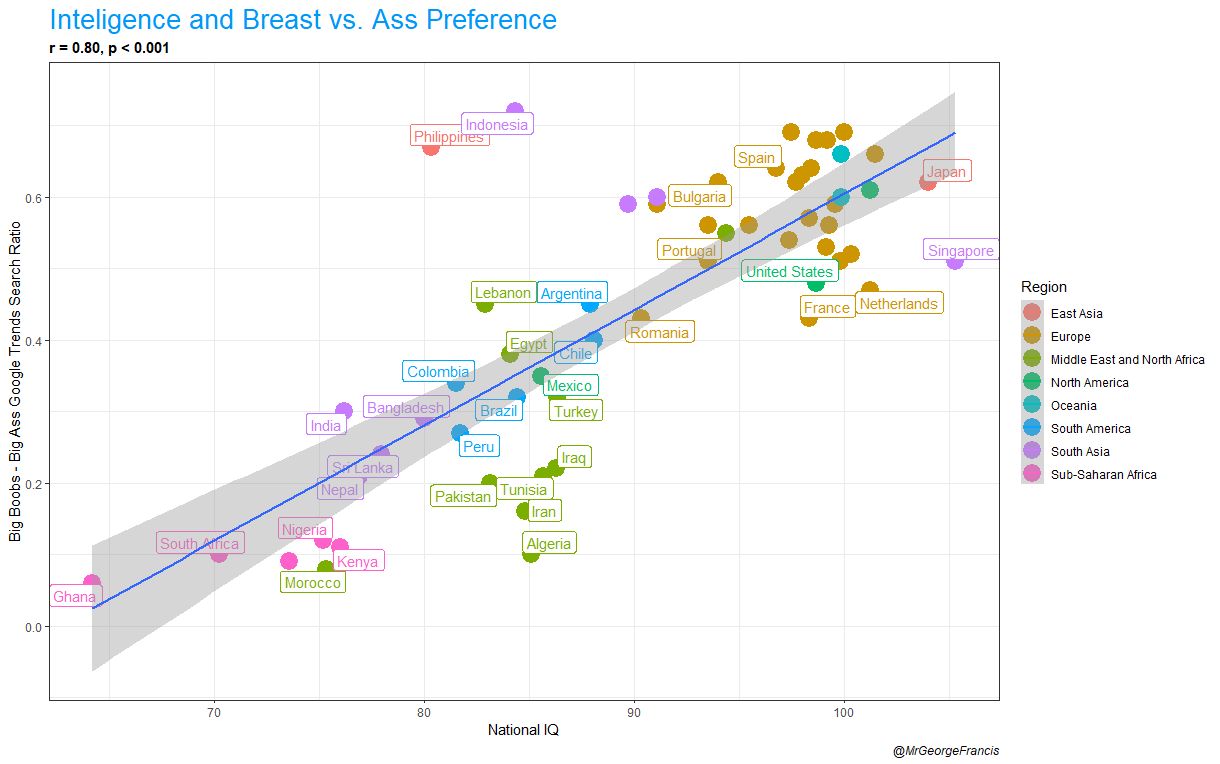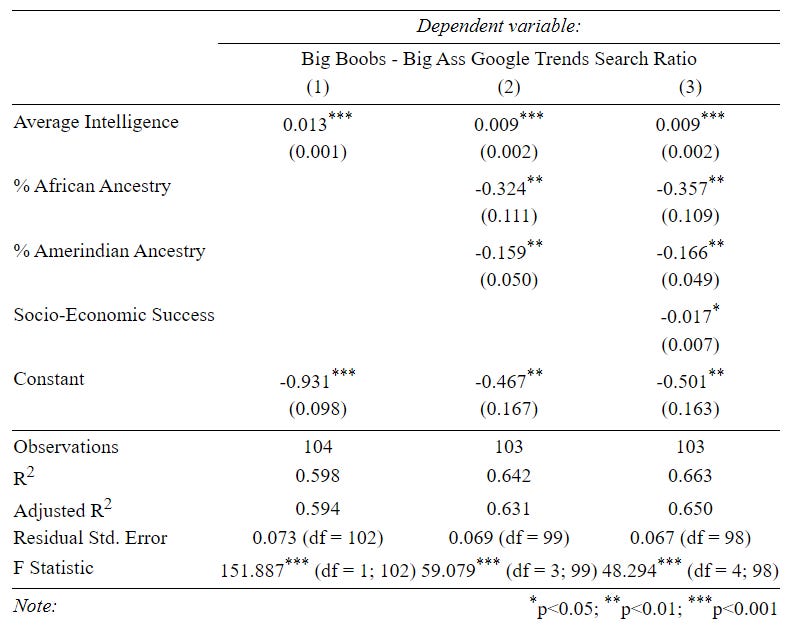*epistemic disclaimer: probably false… unless?*
Why do women have breasts? Our primate relatives don’t have breasts, or rather they only grow and have breasts during pregnancy and the feeding after. There must be some reason why we evolved them yet other species did not.
The most obvious fact about breasts is that they are sexually appealing to males - they are ‘secondary sexual characteristics’. Women develop them during puberty as they are preparing for sexual relations.
And yet the idea that their evolution started out as being sexual characteristics does not really make sense. In the period after giving birth and during breastfeeding, primates are infertile. This is called ‘Lactational amenorrhea‘. In our relative species, breasts signal temporary infertility! So what ape would be attracted to a female with breasts given she is infertile, is caring for an infant and probably being protected by another male.
This is what I call the ‘breast paradox’ - boobs evolved to be sexually desirable features yet this is apparently contradicted by the fact their initial development would have signalled being taken and temporarily infertile.
Some evolutionary biologists, realising the problem of the ‘breast paradox’, suggest non-sexual explanations for their evolution. These ideas include thermoregulation, their evolution as a fat store like a camel’s hump or as a signal of lactational capacity (for a recent and thorough review of evolutionary hypotheses check out this review). Then it is supposed that the sexual role of permanent breasts came later. But these types of explanations do not really make sense. If there were these evolutionary advantages why didn’t other primates evolve them? Why don’t men have breasts too?
But most importantly, even if there were these advantages of permanent breasts any mutations that favoured permanent breasts would have falsely signalled infertility getting it knocked out of the gene pool quickly. Non-sexual explanations of permanent breasts fail to resolve the breast paradox. From what I can see, other researchers haven’t really noticed this.
To resolve this paradox I suggest we bite the bullet. Humans evolved breasts as sexually attractive features precisely because they signalled infertility. A male primate who is not put off by, or even attracted to, breasts will stay with a female protecting her when she is in her most vulnerable state - during pregnancy and just after childbirth. For a female to select for such males improves her chances of successful reproduction. Moreover, in an environment where it is an advantage for males to stay with and support a female, a taste for breasts can keep the male investing in his own interest at the most critical time for support. In essence, permanent breasts had a pre-historic purpose of separating the men from the ‘fuckboys’.
My theory of the evolution of breasts is that they are an adaptation for a slow life history rather than a fast life history. Breasts are K-selected. r-selected animals with a fast life history have short lifespans and mature quickly. K-selected species have longer lifespans, invest more in their children and take longer to mature. Fast life history is an adaptation to unstable ecologies where mortality is more random and uncontrollable so the best option is to have as many offspring as possible. By contrast in predictable environments, there’s an advantage to investing more in offspring to increase their chances.
Breasts by selecting for stable, long-term relationships between males and females facilitate long-term investment in offspring. It makes sense that only humans would have permanent breasts. Compared to other primates we have a slow life history strategy. We live for a particularly long time, take a long time to mature and need substantial resources and protection to develop our large brains.
There are two other features of breasts that hint at them being K-selected. Without bras or plastic surgery, breasts droop (or what biologists call ‘breast ptosis’) with time, making them a very honest signal of age. The larger the breasts, the more ptosis, and the more honest the signal. A fast life history primate will mate with any female who has some signs of fertility, before going on to the next female once she is pregnant. However, a male with a longer time horizon will look for a female without droopy breasts who will bear children for many years and invest in the children for many years. Breasts can thus evolve as an age indicator to facilitate K-selected mating.
One biologist has noted that breasts mimic butt cheeks on the front of the body. I’m not quite sure that is how I would describe it, but the point still stands. Unlike the rear, breasts are on the front of a woman and near her face. This has a key role in facilitating sex from the front and making it enjoyable. In contrast to animalistic positions, like doggy style, the pure ‘missionary’ position is face-to-face and more intimate. It is an emotional experience that can strengthen lasting pair bonds - a handy K-selected use. With the exception of our cousins, the Bonobos and a few other unusual cases, humans are unique in having sex front-to-front. In fact, it is our standard sexual position. We are the only species with permanent breasts and one of the few to engage in missionary sex - two birds with one stone. Occam’s Razor is happy with this theory.
So far I have described my theory of breasts as a K-selected secondary sexual characteristic and argued this theory best explains their functions. By contrast, other popular theories have obvious problems, chiefly they cannot resolve the ‘breast paradox’. But science should make predictions and testable hypotheses. We don’t want to fall into the common critique of Evolutionary Psychology that it is telling ‘just-so stories. So how do we test my theory?
An obvious prediction is that human races that are more K-selected will be more interested in breasts relative to ass and have larger breasts compared to ass cheeks. Once breasts have developed it is logical that r-selection would promote larger secondary sexual characteristics to increase the frequency of mating. However, for the arguments I have laid out K-selection would prefer breasts relative to ass.
So we need a measure of ass versus breast preference in groups and a measure of the level of their life history strategy. If I’m right they will correlate very well. For my measure of ass versus breast preference, I use Google Trends. This allows me to download the respective frequencies of searches for “big boobs” and “big ass” within nations. I then divide the number of searches for “big boobs” by the sum of the searches for both phrases. We shall call this the ‘boob-ass ratio’.
For our measure of slow life history, we will use national IQ - average cognitive ability within countries. “What,” I hear you say, “does intelligence have to do with life history?” In race science, the dimensions of intelligence and life history have generally been studied separately but they always seem to co-occur. Whether we look at lifespan, age of menarche or intelligence we always get the same continuum - East Asians on one side, Africans on the other side and Caucasians in the middle.
Intelligence is almost certainly a slow life history strategy. J Phillippe Rushton noted that large brains require large investments and lots of calories to sustain making them a slow life history strategy. They use 20% of the basal metabolic rate in humans. At the racial level, he argued cranial capacity had a 0.9 correlation with cognitive ability and 0.6-0.9 correlation with fecundity and longevity infant mortality. Across 234 mammalian species, Rushton found large correlations between cranial capacity and gestation time, age of first mating, birth weight and a negative correlation with litter size. Given brain size causally impacts intelligence, it makes sense for intelligence to be a K-selected trait.
A study that came out a year of Rushton’s death showed that artificially selecting fish for larger brains reduced their fertility. I don’t know if this will replicate, but it certainly supports Rushton’s theory of a link between IQ and life history.
What I think Rushton missed is that this relationship might not just be physiological, but it is also likely to be behavioural. Greater intelligence is helpful for planning for the future - considering options and eventual outcomes. In humans, smarter individuals are more patient. I review that literature in this blog post where I comment on the 0.8 correlation between national IQ and interest rates on sovereign bonds. But this relationship extends to non-humans, in a lab experiment of inter-temporal choice tasks for 13 primate species, the species with larger brains were more patient.
So now that I’ve justified my test and approach let’s look at the results.
National IQ explains 64% of the national variation of people searching for “Big Boobs” instead of “Big Ass”. A correlation of 0.8, that’s quite big for the social sciences… As an extra check, I thought I would try replicating my results at a within-country level. I use the dataset from Fuerst and Kirkegaard’s ‘Admixture in the Americas’ papers. They gather data on genetic admixture, average intelligence and the socio-economic welfare for regions in American countries eg. Mexico, USA, Colombia etc.
My theory’s predictions do replicate and the result is almost the same (r = 0.77). Racial ancestry also has an independent association with boob versus ass preference and likewise for socioeconomic status. However, this only slightly moderates IQ’s association with preference for breasts, which is consistent with intelligence and life history strategy causing preference for breasts, rather than any sort of cultural or ethnic confound. The graph is below (I have no idea why Georgians have such an extreme preference for boobs over ass!)
So are you convinced by my theory? I’m not certain myself, after all, I did put an ‘epistemic disclaimer’ at the start of this piece. It seems somewhat outlandish. Is there something I’ve missed? Perhaps there’s an alternative explanation for why smarter groups of men are relatively more likely to enjoy looking at boobs rather than ass?Maybe my dependent variable has a systematic bias against low IQ people for linguistic reasons? Can it really ever be compelling that K-selection could actually promote secondary sexual characteristics, which would presumably increase the frequency of intercourse (all other things being equal)? I’m not sure these critiques are strong, nevertheless, I have some doubt in my theory. Part of that is, to be quite honest, some embarrassment over the topic.
In any case, most novel theories are wrong, but some are right.
CORRECTION: My first graph actually used the search term “big tits” rather than “big boobs”. If alternative search terms for breasts are used (alone or combined), India, Pakistan, Sri Lanka, Nepal and Bangladesh show a much higher preference for boobs.






LMAO
Best evo psych article of all time!
Here is the "cutting-edge" Research for the advancement of SCIENCE that we all needed.
And for that, I thank you, good sir.